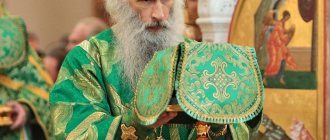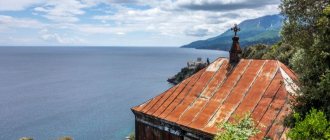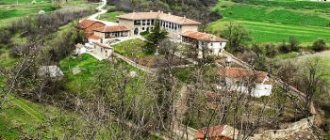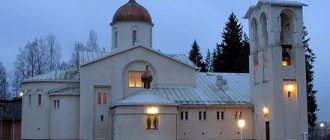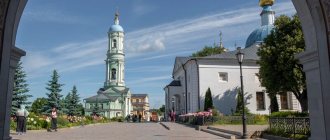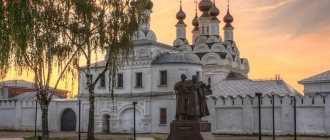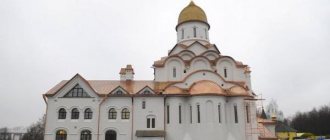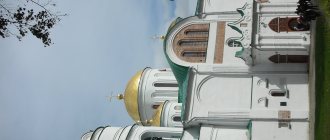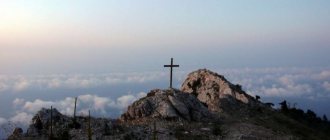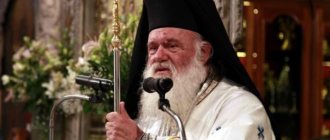Mir
Greece periphery Thessaly Zograf Monastery (Athos) Map loading in progress...
{"format":"leaflet","minzoom":false,"maxzoom":false,"limit":50,"offset":0,"link":"all","sort":[""], "order":[],"headers":"show","mainlabel":"","intro":"","outro":"","searchlabel":"\u2026 \u0441\u043b\u0435\ u0434\u0443\u044e\u0449\u0438\u0435 \u0440\u0435\u0437\u0443\u043b\u044c\u0442\u0430\u0442\u044b","default":"","import-annotation":false,"width ":"auto","height":"350px","centre":{"text":"","title":"""link":"""lat":40.306026000000002795786713249981403350830078125,"lon": 24.16055800000000175487002707086503505706787109375,"icon":""},"title":"","label":"","icon":"","lines":[],"polygons":[],"circles":[ ],"rectangles":[],"copycoords":false,"static":false,"zoom":8,"defzoom":14,"layers":["OpenStreetMap"],"image layers":[] ,"overlays":[],"resizable":false,"fullscreen":true,"scrollwheelzoom":true,"cluster":false,"clustermaxzoom":9,"clusterzoomonclick":true,"clustermaxradius":80, "clusterspiderfy":true,"geojson":"","clicktarget":"","showtitle":true,"hidenamespace":false,"template":"","userparam":"","activeicon": "","pagelabel":false,"ajaxcoordproperty":"","ajaxquery":"","locations":[{"text":"\u003Cb\u003E\u003Ca href=\"/palomnik/%D0% 9C%D0%BE%D0%BD%D0%B0%D1%81%D1%82%D1%8B%D1%80%D1%8C_%D0%97%D0%BE%D0%B3%D1%80% D0%B0%D1%84_(%D0%90%D1%84%D0%BE%D0%BD)\» title=\»\u041c\u043e\u043d\u0430\u0441\u0442\u044b\u0440\u044c\ u0417\u043e\u0433\u0440\u0430\u0444 (\u0410\u0444\u043e\u043d)\»\u003E\u041c\u043e\u043d\u0430\u0441\u0442\u044b\u0440\u044c \u0417\u043e\u0433\ u0440\u0430\u0444 (\u0410\u0444\u043e\u043d)\u003C/a\u003E\u003C/b\u003E\u003Chr /\u003E\u003Ca href=\"/palomnik/%D0%A1%D0%B2% D0%BE%D0%B9%D1%81%D1%82%D0%B2%D0%BE:%D0%90%D0%BD%D0%BD%D0%BE%D1%82%D0%B0%D1 %86%D0%B8%D1%8F\" title=\"\u0421\u0432\u043e\u0439\u0441\u0442\u0432\u043e:\u0410\u043d\u043d\u043e\u0442\u0430\u0446\u0438\ u044f\u003E\u0410\u043d\u043d\u043e\u0442\u0430\u0446\u0438\u044f\u003C/a\u003E: »'\u0417\u043e\u0433\u0440\u0430\u0301\u0 444"' \u2014 \u0431\u043e\u043b\u0433\u0430\u0440\u0441\u043a\u0438\u0439 \u043c\u043e\u043d\u0430\u0441\u0442\u044b\u0440\u044c u0430\u0421\u0432\u044f\u0442 \u043e\u0439 \u0413\u043e\u0440\u0435 \u0410\u0444\u043e\u043d, 9-\u0439 \u0432 \u0438\u0435\u0440\u0430\u0440\u0445\u0438\ u0438\u0430\u0444\u043e\ u043d\u0441\u043a\u0438\u0445 \u043c\u043e\u043d\u0430\u0441\u0442\u044b\u0440\u0435\u0439, \u043f\u043e\u0441\u0432\u044f\u 0449\u0451\u043d\u0441\u0432 . \u0413\u0435\u043e\u0440\u0433\u0438\u044e \u041f\u043e\u0431\u0435\u0434\u043e\u043d\u043e\u0441\u0446\u0443","title":"\u041c\u 043e\u043d\ u0430\u0441\u0442\u044b\u0440\u044c \u0417\u043e\u0433\u0440\u0430\u0444 (\u0410\u0444\u043e\u043d)","link":"","lat":40.306026000000 002795786713249981403350830078125,”lon ":24.16055800000000175487002707086503505706787109375,"icon":""}],"imageLayers":[]}
40.27819; 24.217071
Greece, periphery of Thessaly, autonomous monastic state of the Holy Mountain
periphery Thessaly
Greece
Zograf
- Bulgarian monastery on Holy Mount Athos, 9th in the hierarchy of Athonite monasteries, dedicated to St. St. George the Victorious; one of three traditionally Slavic inhabitants. The Zograf Monastery (Bulgarian: Zografski manastir; Greek: Μονή Ζωγράφου) is located in the western part of the peninsula, 3 km from the sea, in a picturesque forested gorge. The closest neighboring monastery is Kostamonit, located 3 km from Zograf. The buildings that now exist were built mainly in the 18th - 19th centuries. Patronal feast day: April 23 (May 6), Great Martyr George the Victorious.
History[[edit]h2>
Name Zograf
means
Painter
.
Founded during the reign of Leo the Philosopher by three brothers, natives of the city of Ohrid in Bulgaria: Moses, Aaron and John. At first they settled in cells, on separate pillars, but then they built a common temple, having received a revelation in prayer to dedicate it to the name of the Great Martyr George, whose face itself was depicted on a board prepared for icon painting. The founders called their patron, who miraculously depicted himself, a painter ( Ζόγραφος
) and the monastery itself was nicknamed from the icon, where pilgrims began to come, attracted by rumors of a miracle, especially when rumors from Palestine reached the capital about the disappearance of the image of St. George, in a monastery near Lydda. The local monks came to Athos and recognized the image in Zograf as identical with the image that they had. Leo the Philosopher and Tsar John of Bulgaria were also attracted by rumor to worship the miraculous image of St. in Zograf. George and donated significant contributions for the completion of the monastery.
Under Michael Palaeologus, Zograf, as refusing to join the union, was ruined. On October 10, 1276, in the tower of the monastery, the Latins burned 26 martyrs who opposed the union with Rome.
The monastery was restored by the Moldavian governor Stephen III the Great only in 1502.
In July 1913, during the Second Balkan War, the monastery, which housed a Bulgarian military detachment, was stormed by the Greeks; Bulgarian soldiers were taken to Greece as prisoners of war.
Zograf Monastery
One of the oldest Athonite monasteries is located in the northwestern part of the peninsula among a dense picturesque forest. The small monastery plateau is hidden in a kind of mountain bowl, hugging it on three sides. From the sea, the approach to the monastery is hampered by a deep chasm of a ravine, along the edge of which a road leading to the pier has been carved into the rocks. It's about an hour's walk away. Approximately the same distance to the nearest Kostamonit, to Hilandar and Karei a little more than three hours on foot.
Tradition attributes the founding of the monastery to three brother monks: Moses, Aaron and John - immigrants from the ancient Bulgarian capital of Ohrid. Having chosen a secluded place for monastic deeds, they settled in separate cells on pillars. But soon they came together and built a small temple. Through the fervent prayer of the monks, the Lord miraculously revealed to which of the saints the new church should be dedicated. On a clean icon board, left in the temple for one night, the image of St. Vmch. St. George the Victorious. This miraculous self-painted icon is reverently preserved in the monastery to this day, constituting one of its main shrines. She also gave the name to the monastery - Zograf, in Greek painter or picturesque. One day, a bishop visiting the monastery doubted the miraculous origin of the icon and dared to touch the face of the saint with his finger. The wrath of God was not slow to punish the blasphemer; the finger became firmly attached to the board, so that it had to be cut off. As Athonite pilgrims testify, his trace is still visible today.
It is remarkable that at the same time as the icon appeared on Mount Athos, in the Phanuel Monastery near the Syrian city of Lydda (the birthplace of St. George), the image of the saint separated from the icon board, rose into the air and disappeared. In a vision, the holy warrior himself commanded the abbot of the monastery to leave the monastery, for he must suffer from the barbarians, and to go with the brethren to Athos “to the place that I found for myself in the inheritance of the Mother of God.” The abbot and some of the brothers left their previous place and moved to Zograf, where they ended their days peacefully.
According to legend, the foundation of the monastery dates back to the 6th–7th centuries. It is believed that the pious Emperor Leo the Wise and the Bulgarian Tsar John granted the monastery lands and rich deposits. Documentary evidence dates back to the 10th century. The first Typikon of Athos in 972 was signed, among others, by Abbot George of Zografsky, and the first deed of land kept in the monastery dates back to 980.
The further fate of the monastery was not so favorable. In the 12th–13th centuries, the monastery suffered destruction and fires from the Crusaders and Uniate Latins. Catalan pirates caused enormous disasters in 1307–1309, plundering valuables and killing many monks. The emperors of the Palaiologan dynasty, Andronikos II and John V, helped in the restoration of Zograf. The short-lived heyday is associated with the activities of the Serbian ruler Stephen IV Dusan (1458–1502). His small army, without knowing defeat, fought against the Turks for many years under the gracious leadership of St. Vmch. St. George the Victorious. The miraculous icon of the holy warrior was constantly with the army. Having completed his feats of arms, Stephen IV, in fulfillment of his vow, placed the miraculous image in the cathedral church of Zograf and renovated all the monastery buildings.
The special favor of the monastery from its heavenly patron was marked by another miraculous event. The waves of the Aegean Sea brought the icon of St. Vmch. St. George the Victorious. The monks of nearby monasteries entered into a dispute over the possession of the shrine. But, wanting to allow the will of God to be accomplished, the found icon was placed on the back of a young mule and set off along unfamiliar Athonite paths. To the great joy of the brethren, a few days later the mule was found on a hill opposite Zograf. Image of St. The passion-bearer was reverently transferred to the cathedral church, and a small church in the name of St. George was built on the hill.
Starting from the 18th century, the appearance of a monastery-fortress, characteristic of the Holy Mountain, gradually took shape. In 1716, the south-eastern wall, including the fraternal cells, was erected from local granite. Between 1862–1896, the northern and eastern line of the walls were restored with a hotel, a large refectory and the Church of Sts. equal to Cyril and Methodius above her. The western wall closes the buildings - the highest and most powerful.
Directly opposite the Holy Gates is the large cathedral church of St. George the Victorious (celebration takes place on April 23/May 5). Erected in 1801 in the typical Byzantine architecture traditions of Athos, later in 1817 it was painted with frescoes. The temple is three-apse, built of alternating slabs of cut stone and brick. In many places of the masonry there are inclusions of white stone reliefs. The large dome of the temple rests on four powerful marble columns. The main treasures of the temple are the revered miraculous icons of St. St. George the Victorious - placed on columns. The oldest of them is the revealed icon of St. George "in a silver-gilded robe, sent from St. Petersburg with the blessing of Metropolitan Seraphim." All three images are painted according to old Byzantine iconography: St. George appears in the form of a beautiful young warrior in armor and with a spear in his hands. His posture and face are completely calm, devoid of any movement.
To the right of the monastery gates is the small Church of the Dormition of the Mother of God, built in 1764; the paintings date back to 1780. The miraculous Akathist icon of the Mother of God resides here. According to legend, to the elder who read the Akathist before her every day, the Queen of Heaven announced the coming test: “The enemies of the Orthodox faith are close: whoever is weak in the spirit of patience, let him hide until the temptation passes, but let those who desire suffering crowns remain.” It is known from the chronicle that in October 1276, Uniate Latins entered the monastery, demanding that the Orthodox submit to Rome. Twenty-six monks with the icon of the Mother of God locked themselves in the tower. They all suffered martyrdom in the fire, and the icon was found unharmed in the ashes. In the place where the tower once stood, a monument-tombstone to the martyrs was erected. During its consecration in October 1873, a pillar of fire appeared in the night sky above the temple, which then moved towards the monument and turned into a circle like a shining halo.
There is a marble phial at the northwestern corner of the cathedral church. Above it is a canopy, the dome of which is supported by three-lobed arches on graceful columns with high capitals. Inside the bowl is a marble figure of a monk.
In addition to the cathedral and the Church of the Assumption, on the territory of the monastery there are chapels: the Transfiguration of the Lord, the Holy Archangels, the Nativity of John the Baptist, the Great Martyr. Demetrius of Thessalonica, Annunciation, St. Nicholas of Myra, Protection of the Most Holy Theotokos, St. Spyridon of Trimifuntsky, Twenty-six Martyrs of Zograf. Outside the monastery there are eight more small churches. In Kareya the monastery owns the cell of the Transfiguration of the Lord and two workshops.
A huge number of relics are kept in the cathedral temple of Zograf. Particularly revered among them are parts of the Tree of the Life-Giving Cross of the Lord, parts of the relics of the Holy Great Martyr George and his blood. And also other shrines: the head of the Venerable Matrona of Chios and two parts of her legs; jawbone of the Venerable Martyr Stephen the New; parts of the relics of St. Archdeacon Stephen, Hieromartyrs: Ignatius the God-Bearer, Antipas and Charalampios; St. martyrs: Nikita, Nestor, Varlaam, Kirik; St. Great Martyr Theodore Stratelates; Venerable Theodosius the Great; St. Vmch. Mercury; St. Apostle Andrew the First-Called; St. Auxentia; St. Apostle and Evangelist Matthew; St. Great Martyr Jacob the Persian; St. Eutyches, Patriarch of Constantinople; St. the unmercenary Cosmas and Damian; St. Cyrus and John; St. Great Martyr Panteleimon and St. Martyr Tryphon; St. Peter and Athanasius, Patriarchs of Alexandria; Hieromartyr Clement; Hieromartyr Ferapont and others.
In the altar of the cathedral there is a miraculous icon of the Mother of God, called the “Quick to Hear”. According to legend, in front of this image the monk Cosmas prayed with special zeal for the salvation of his soul. Soon a voice came from the icon commanding him to retire to the desert for a hermit’s life. He left the monastery and settled in a cave in the middle of a low mountain. The described events date back to the end of the 14th and beginning of the 15th centuries. The cave of Cosmas of Zografsky is located about half an hour's walk from the monastery and today is reverently visited by pilgrims.
The library contains 126 Greek and 388 Slavic handwritten documents, 26 of the most ancient ones written on parchment. Of the ten thousand printed books stored in the library, the majority are in Bulgarian. In the second half of the 18th century, the learned monk Paisiy lived and worked on compiling the “History of the Bulgarian People” in Zograf. Today, ten Bulgarian monks work in the monastery. Zograf occupies ninth place in the monastic hierarchy of Athos.
Shrines[[edit]h2>- The cathedral church, which contains three icons of the Great Martyr George from different times, was built in 1801, on the site of an older church.
- the oldest miraculous icon of St. George is placed at the column of the right choir of the temple, and two copies from it, which came to the monastery from other places, are considered, according to legends about them, miraculous; the second icon, according to legend, sailed by sea from Arabia, and the third - Stefan Dushan, found by him in a vision and accompanied him in battles.
- icon of the Most Holy Theotokos, called Akathist.
- The Zograf Gospel, presented by the monks to Alexander II, who donated it to the Imperial Public Library.
- Icon of the Most Holy Theotokos “Hearer”.
Igor Malikov. Pilgrimage to Athos. At the Zograf Monastery
Monastery of St. Panteleimon
Great Lavra and Iversky Monastery
At the Vatopedi monastery
In the monastery of Esphigmen
We stopped at a cross on a concrete base, heading to the cave of the ascetic Cosmas. We drank coffee from a thermos, which we had strained in a coffee machine back in Vatopedi, and Mitya and Dima went on reconnaissance to look for a cave. Fifteen minutes later we heard calling cries. Father Sergius remained to rest at the cross, and I galloped towards the screams. Ten minutes later I was at a sheer forest cliff, its top reaching into the sky. Steep, narrow steps along a sheer rock lead into the cave itself, and in order not to fall, you need to hold on to a narrow iron rod stretched along the wall. Got up. The inside of the cave is cozy, there is a table and a chair, and a cabinet with lamps. I took photographs, and Dmitry wrote something in the visitors' book. It has been there since 2010, judging by the dates of the records. And from the cave there is a magnificent view of the mountains surrounding the Zograf monastery, white with its walls. So we are already close.
That's it, let's go downstairs, pick up our luggage and continue on our way. The trees create a thick crown overhead and twilight envelops us, only occasionally parting to lure us with the view of the most beautiful sheer cliffs emerging from the depths of the forest on the opposite side of the gorge. The forest ends and we come out into a clearing and are speechless: indeed, as in a fairy tale, in the forest there seems to be a monastery hanging in the air, and a rocky path stretches towards it, going around the bend. We are wet, tired and happy as we go up to the monastery.
Zograf Monastery – Bulgarian. Here, most of the monks are somehow connected with Bulgaria. Therefore, everyone understands Russian and smiles good-naturedly. Monks are generally good-hearted people. They love Russians here. The evening service is held in Russian, clearly and simply, as in Moscow. The temple is extremely beautiful. After the service there is a modest meal, albeit with a glass of dry red wine. And they don't serve tea at all. All food is washed down with water. One of the pilgrims told me that Greeks drink tea only when they are sick. How quickly these four days flew by...
The all-night vigil began at eight and lasted until one in the morning. In the morning at 7 Liturgy. Then a meal, after which we run out of Zograf, loaded with our luggage. Mitya and his father and Dmitry Minsky remain in Zograf and then go to Hilandar, this is a Serbian monastery. Father Sergius and I go out in the company of novice Ivan - he is from Latvia, but plans to stay in the Bulgarian monastery. The weather turns bad, it rains, and we hurry along the mountain road down to the pier, where the ferry to Ouranoupolis leaves at about one o'clock in the afternoon. You can't be late - the ferry will leave and there will be no more ships.
The rain was falling more and more heavily. I'm already all wet, it's good that I have a spare jacket. A police jeep is coming towards us, and Ivan, having said goodbye to Father Sergius and me, sits down with the police on the way back to the monastery. We're in a hurry. When we descend closer to the sea, it becomes clear that our plans have collapsed. Stormy wind and rain. In such weather, the ferry will not moor to the pier, even if it goes out to sea. We sit and wait for something. I'm trying to find people to ask: what to do and where to run. The prospect of dragging backpacks up the mountain back to Zograf in the rain and wet clay is not a happy one. I found some monk, but he doesn’t speak English. All I understood was that there was a ferry and there was no need to wait: “no feribot”.
Father Sergius goes on reconnaissance, and I study the map trying to figure out how to get to Ouranoupolis on foot through the mountains. According to the map, it's about five hours, if you don't go astray. Okay, I think that we all rely on our own strengths, we need to turn to the Mother of God, she is the mistress here, and everything will be decided. I open the akathist, I just started reading, Father Sergius is running. We take our things and run to the square to the pier. There is a beige Land Rover Defender parked there, with some priest driving it. We drop our things and head back to the mountains. On the way, he explains, speaking quite well in Russian, how we can get to Ouranoupolis on foot. I check with the navigator, everything seems to be correct.
We disembark on the mountain, say goodbye, the priest says that if we follow the road, then maybe someone will pick us up. Backpacks on shoulders and forward. Let's go together, then. The road goes up and down. But mostly up. After an hour of walking like this, I’m already breathing heavily, I don’t have the strength to speak at all. We exchanged luggage: I took Sergius’s father’s sports bag, he took my backpack. Walking became completely sad. There is a fork with an apiary and some kind of booth, I look at the device, it shows that we have covered approximately 10 percent of the required distance. And there is minimal health left. But we go anyway, but what should we do? A Unimog truck is driving, there are familiar Georgians in the cab, but there is no room. And they drove by as if they didn’t know us. You won’t be lucky in the back, these are the rules, it’s useless to beg. We move on, we don’t even walk, we crawl. SUVs with people drove by twice, but in the other direction. We won’t even get to nightfall at this rate. I figure out the worst option, with spending the night in the forest (as happened with Mitya and his father four days ago) and somehow I feel completely sad: a bottle of water for two, a bottle of wine, no food, matches or warm clothes. There are only delicious berries that grow on bushes. It looks like candy, I don’t know what it’s called.
I walk with these thoughts, remembering the warm, cozy room in Zograf... Maybe I’ll rush back, and then somehow everything will be resolved, well, let’s say we miss the plane, we’ll have to wait three more days until Monday, it seems the next flight to Moscow will only then. The engine is humming from behind, I raise my hand, maybe I’ll get lucky. A silver Toyota Hilux, an off-road pickup truck, stops. There are some guys sitting in the cab, the body is empty. Not our option, obviously, it’s busy. I still ask the driver whether we are going there or not. The driver, by the way, is Russian. When he heard that we were walking to Ouranoupolis, his eyes widened in surprise. I explain to him that the ferry is not running due to the storm, and there is a flight tomorrow. I ask you to at least take us up the mountain, until we turn onto the path. The driver took pity: get into the back, he said. We left our luggage and jumped into the back, sitting on a plastic box.
The car started moving, I had to grab onto the chrome arches on the sides and roof. How good, Lord! We are driving, the engine is murmuring, the wheels are shaking the damp clay and the jeep with six people and luggage is rowing up the mountain quite briskly, splashing mud along the side of the road. The rain has almost stopped, but it is cold and my hands are freezing. I'm trying to take pictures, but the shaking is terrible and I have to hold on to the bars so as not to fall out of the jeep on the rise. I took out my navigator and tracked our movements on the map. Don't miss the turn to the trail to Ouranoupolis. While we’re driving, I’m wondering how we’ll climb the mountains with our luggage. We've been driving uphill for about twenty minutes. It takes us three or four hours to walk. I look at the navigator again, horror, either the driver forgot, or we didn’t remind, in short, we passed the turn and then the road went downhill. That is, we are going from one side of the peninsula to the other. Hilandar monastery on the map. We need to knock on the cabin, I think maybe it will stop and we’ll go. On the other hand, whether it will be as it will be is not for us to decide. Let's move on. The shaking is such that you can jump off the side if you don’t hold on. And I’m frozen, Father Sergius has a waterproof jacket, and I’m in a thin T-shirt and a hoodie, and I’m all wet. Meanwhile, the landscapes overboard are unique, mountains covered with coniferous trees give way to leafy ravines, between which sharp rocks can be seen. In one of these rocks I noticed something similar to caves, and even a house. Probably a hermit or a monastery, there are a lot of them here, but it’s impossible to get to them without having the appropriate experience and equipment. Wow, a blue strip of sea and a tower crane appeared below. And behind the tap are the white walls of the Hilandar Monastery.
